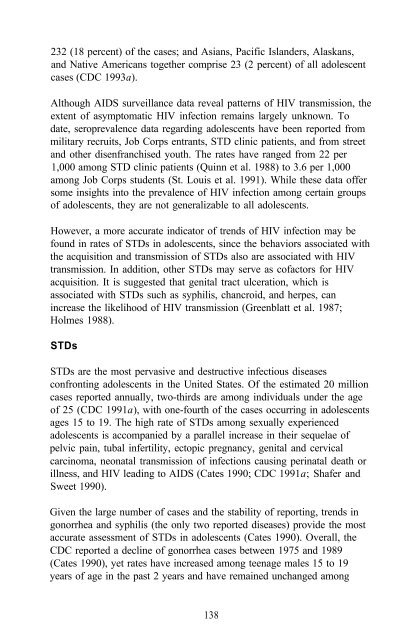The Context of HIV Risk Among Drug Users and Their Sexual Partners
The Context of HIV Risk Among Drug Users and Their Sexual Partners
The Context of HIV Risk Among Drug Users and Their Sexual Partners
Create successful ePaper yourself
Turn your PDF publications into a flip-book with our unique Google optimized e-Paper software.
232 (18 percent) <strong>of</strong> the cases; <strong>and</strong> Asians, Pacific Isl<strong>and</strong>ers, Alaskans,<br />
<strong>and</strong> Native Americans together comprise 23 (2 percent) <strong>of</strong> all adolescent<br />
cases (CDC 1993a).<br />
Although AIDS surveillance data reveal patterns <strong>of</strong> <strong>HIV</strong> transmission, the<br />
extent <strong>of</strong> asymptomatic <strong>HIV</strong> infection remains largely unknown. To<br />
date, seroprevalence data regarding adolescents have been reported from<br />
military recruits, Job Corps entrants, STD clinic patients, <strong>and</strong> from street<br />
<strong>and</strong> other disenfranchised youth. <strong>The</strong> rates have ranged from 22 per<br />
1,000 among STD clinic patients (Quinn et al. 1988) to 3.6 per 1,000<br />
among Job Corps students (St. Louis et al. 1991). While these data <strong>of</strong>fer<br />
some insights into the prevalence <strong>of</strong> <strong>HIV</strong> infection among certain groups<br />
<strong>of</strong> adolescents, they are not generalizable to all adolescents.<br />
However, a more accurate indicator <strong>of</strong> trends <strong>of</strong> <strong>HIV</strong> infection may be<br />
found in rates <strong>of</strong> STDs in adolescents, since the behaviors associated with<br />
the acquisition <strong>and</strong> transmission <strong>of</strong> STDs also are associated with <strong>HIV</strong><br />
transmission. In addition, other STDs may serve as c<strong>of</strong>actors for <strong>HIV</strong><br />
acquisition. It is suggested that genital tract ulceration, which is<br />
associated with STDs such as syphilis, chancroid, <strong>and</strong> herpes, can<br />
increase the likelihood <strong>of</strong> <strong>HIV</strong> transmission (Greenblatt et al. 1987;<br />
Holmes 1988).<br />
STDs<br />
STDs are the most pervasive <strong>and</strong> destructive infectious diseases<br />
confronting adolescents in the United States. Of the estimated 20 million<br />
cases reported annually, two-thirds are among individuals under the age<br />
<strong>of</strong> 25 (CDC 1991a), with one-fourth <strong>of</strong> the cases occurring in adolescents<br />
ages 15 to 19. <strong>The</strong> high rate <strong>of</strong> STDs among sexually experienced<br />
adolescents is accompanied by a parallel increase in their sequelae <strong>of</strong><br />
pelvic pain, tubal infertility, ectopic pregnancy, genital <strong>and</strong> cervical<br />
carcinoma, neonatal transmission <strong>of</strong> infections causing perinatal death or<br />
illness, <strong>and</strong> <strong>HIV</strong> leading to AIDS (Cates 1990; CDC 1991a; Shafer <strong>and</strong><br />
Sweet 1990).<br />
Given the large number <strong>of</strong> cases <strong>and</strong> the stability <strong>of</strong> reporting, trends in<br />
gonorrhea <strong>and</strong> syphilis (the only two reported diseases) provide the most<br />
accurate assessment <strong>of</strong> STDs in adolescents (Cates 1990). Overall, the<br />
CDC reported a decline <strong>of</strong> gonorrhea cases between 1975 <strong>and</strong> 1989<br />
(Cates 1990), yet rates have increased among teenage males 15 to 19<br />
years <strong>of</strong> age in the past 2 years <strong>and</strong> have remained unchanged among<br />
138
















